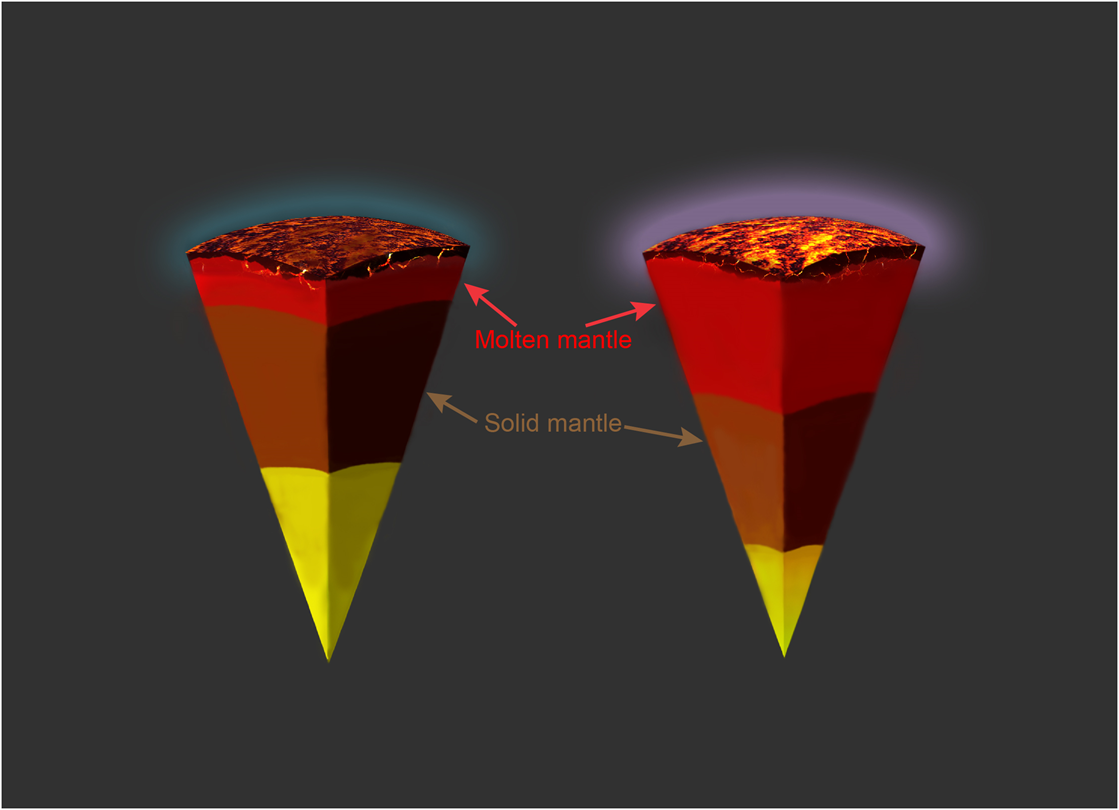Oxygen controls on magmatism in rocky exoplanets - Drs. Yanhao Lin and Ho-Kwang Mao
NOVEMBER 4, 2021
New work published in the Proceedings of the National Academy of Sciences by HPSTAR’s Yanhao Lin and Ho-Kwang “Dave” Mao — with collaborator Wim van Westrenen of Vrije Universiteit Amsterdam — demonstrates that oxygen is essential for rock to melt, and the more oxygen you add to rock, the more easily you can make magma.
Oxygen is essential to life on Earth, and is the most abundant element in the rocky outer layers of the Earth as well as the other terrestrial planets in our solar system. The abundance and activity of refractory oxygen in a rock is described using the oxygen fugacity (fO2 ), commonly quantified relative to mineral redox buffers. Mantle oxygen fugacities can change significantly during planetary growth, differentiation, and subsequent evolution. Melting drives the primary differentiation of rocky planets into metallic core and silicate crust and mantle.
Although melting drives planetary differentiation, the effect of fO2 on rock melting has not been studied directly to date, with prior efforts focusing on fO2-induced changes in the valence ratio of transition metals (particularly iron) in minerals and magma. The researchers performed melting experiments using a synthetic iron-free basalt at oxygen levels representing reducing (log fO2 = -11.5 and -7) and oxidizing (log fO2 = -0.7) interior conditions observed in our solar system.
The experimental results show that the liquidus of iron-free basalt at a pressure of 1 atm is lowered by 105 ±10 °C over a 11 log fO2 units increase in oxygen abundance. This effect is comparable in size to the well-known enhanced melting of rocks by the addition of H2O or CO2. This implies that refractory oxygen abundance can directly control exoplanetary differentiation dynamics by affecting the conditions under which magmatism occurs, even in the absence of iron or volatiles. Exoplanets with a high refractory oxygen abundance exhibit more extensive and longer duration magmatic activity, leading to more efficient and more massive volcanic outgassing of more oxidized gas species than comparable exoplanets with a lower rock fO2 .

Caption: Cartoon illustrating the structure of rocky exoplanets with identical relative cation abundances and thermal profiles at low (left) and high (right) planetary oxygen fugacity during their magma ocean stage. Oxidized planets have smaller metal cores (yellow), deeper magma oceans (red) and thicker, more oxidized atmospheres (purple). Solid lower mantles shown in claret.
Conceptually, oxygen can "wake up rocks" – oxygen-rich rock meltseasier and faster, magma generation models need to be revised.
氧作为地球岩石圈层以及太阳系中其他类地行星中含量最丰富的元素,它不仅对地球上的生命至关重要,也影响着行星内部的性质,包括金属核的分异、核部的成分和壳幔矿物组分。行星内部的氧浓度通常用氧逸度来表示,其决定了在行星形成初期排气过程中的挥发分的组成,即同时也影响着大气成分。地球大气层和地核的氧含量存在巨大差异:前者富含氧气,而后者含氧量很少。大气和地核之间岩石中的氧含量各不相同。许多地质学家认为,这些不同的氧含量没有太大意义,其差异被认为主要跟铁的氧化或者还原性质有关。如果岩石含有大量氧,铁就会被氧化(就像生锈一样);如果可用的氧很少,铁可以以金属形式存在。北京高压科学研究中心的林彦蒿博士、毛河光院士和阿姆斯特丹自由大学的Wim van Westrenen教授合作发表在PNAS的最新的实验结果表明:与含氧量较少的岩石相比,富含氧的岩石更容易融化(>100 ℃)。另外,他们实验合成的是不含铁的岩石成分,因此进一步证明了,这种‘富氧易熔’的效果不是由铁的氧化引起的,而是由氧原子本身引起的—也可以说,氧是地球和行星的“唤醒剂”。
